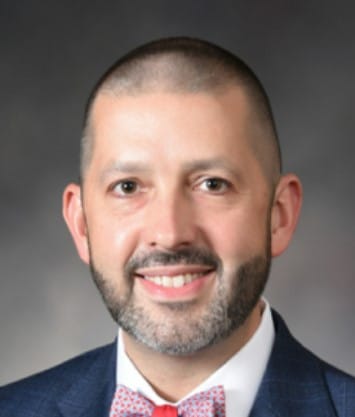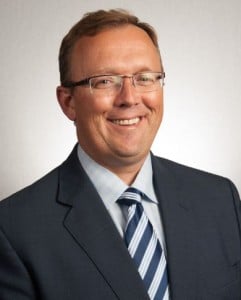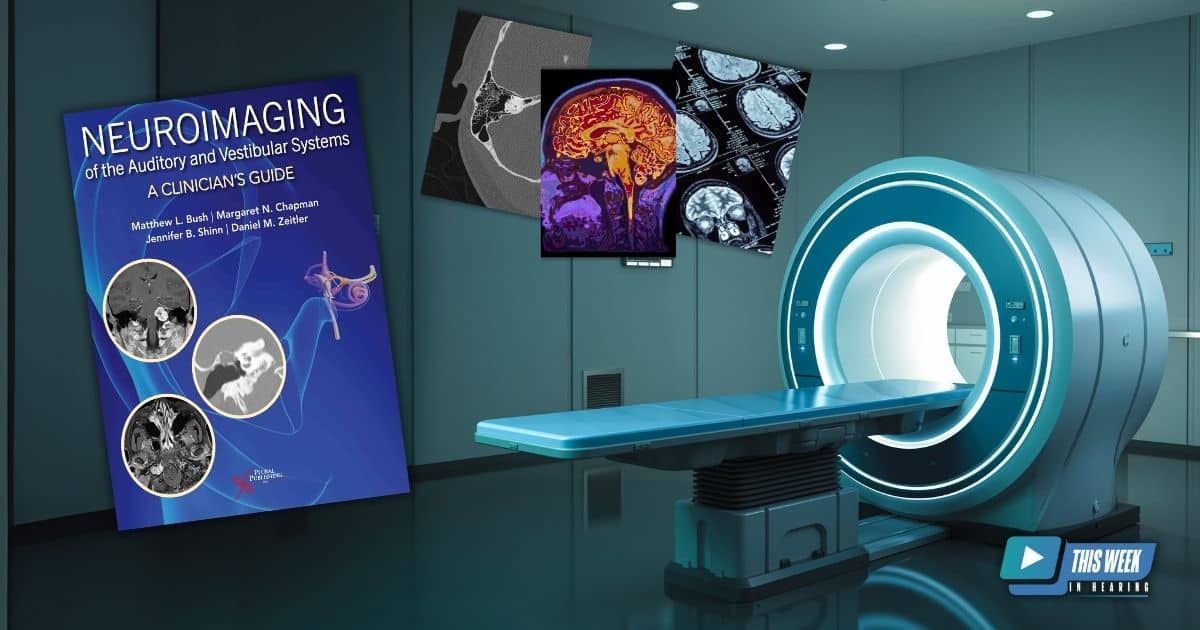Neuroimaging is an essential tool in diagnosing and managing complex auditory and vestibular conditions, and the new textbook Neuroimaging of the Auditory and Vestibular Systems: A Clinician’s Guide is designed to equip healthcare professionals with the knowledge needed to excel in this field.
In this discussion, Dr. Matthew Bush, otolaryngologist and department chair at the University of Kentucky, highlights the book’s multidisciplinary approach, combining perspectives from audiology, radiology, and otology to provide a comprehensive resource for clinicians. The text systematically explores the anatomy, pathology, and imaging findings of the auditory and vestibular systems, offering practical insights for identifying and managing complex conditions.
As audiologists in some states gain the ability to order imaging, this book becomes increasingly relevant for professionals aiming to meet the evolving demands of patient care. By bridging gaps between disciplines, the textbook promotes collaborative communication and enhances diagnostic accuracy. Dr. Bush also discusses the broader importance of integrating neuroimaging into clinical practice, not just for all healthcare providers involved in hearing and balance care.
- For more information on the new textbook, visit the Plural Publishing website
Full Episode Transcript
Hello and welcome to another episode of this Week in Hearing. I’m your host Brian Taylor. This week my guest is Dr. Matthew Bush, who’s an otolaryngologist and department chair at the University of Kentucky. He’s also the co author of a new Plural textbook, Neuroimaging of the Auditory and Vestibular System. I’d like to take this time to give a warm welcome to Dr. Bush. It’s great to have you with us. Great to be with you. Thanks for the opportunity to chat. Sure. Before we dive into the new book, could you tell us a little bit about your background and some of your professional interests? Absolutely. Yeah. So I’ve done a lot of my professional training as well as my clinical practice in Kentucky, but I’m originally from West, Virginia. Did my medical school training at Marshall University in Huntington, West Virginia where I was exposed to lots of opportunities to be involved in rural primary care as rural specialty care, which has some influence in some of my later career choices and academic pursuits. But did my residency here in Lexington, Kentucky at the University of Kentucky and then spent some time in Columbus, Ohio at Ohio State where I was doing a postdoc research fellowship as well as a neurotology and lateral skull based surgery. So after I finished my fellowship I came back here to the Kentucky and began my clinical practice as well as my research career. I began to investigate rural health disparities, access to care challenges and been involved in developing an NIH funded program related to pragmatic research and clinical trials to improve access to hearing health care. So my clinical practice primarily focuses on ear hearing balance care and lateral skull based surgery. I also see from your bio that you have an MBA. I do indeed. Yeah. So an MBA teaches you how much you don’t know about business and about especially in business and medicine. But it was something that began around 2018 and finished it actually during the COVID pandemic. So but it was something really helpful as far as just some understanding of some of the complexities that influence you know, the changes in healthcare economically as well as just leadership development and growth in academic medical centers. Good to know. I have a copy of your book right here. I see. I don’t. Are the co authors are they also affiliated with the University of Kentucky? One of the co editors is so Jennifer Shin is our director of audiology and a full professor, tenured professor here at the University of Kentucky. And the other two are friends and colleagues. So Dr. Daniel Zeitler is a neurotologist and lateral skull based surgeon at Virginia Mason Medical center in Seattle, Washington. Daniel and I trained around the same time and have been a part of a lot of research and educational activities involving our professional societies within otology and neurotology. And then Dr. Margaret Chapman is a neuroradiologist who previously was employed at Virginia Mason. She now works at NYU in the radiology department. So it’s a really great group you know, from audiology and neuroradiology and otology, neurotology. So we’ve really, we’ve, we’ve laughed and learned and cried through working on a book together. But we’re still friends, which is most important to, to all of us. I know it’s not easy to find time to, to write chapters for textbooks. So thanks for. You kind of corrected me. You’re more, I think it’s better probably to call you co editors rather than co authors. Correct So maybe tell us a little bit about some of how many authors are and how many chapters. Maybe give us an overview or a layout of the book. Yeah so I’ve got my copy too because you know it’s. You put it out of sight out of mind. But we’ve got 10 different chapters in this book. And the organization of those chapters is based on anatomy of the auditory and vestibular system. So it really is a nice progression through the anatomic auditory and vestibular vestibular pathways. But they are standalone and independent of each other, which is great. And our goal was, is to identify you know, teams of authors who could come together. Some of them maybe a resident or fellow, maybe a participant, but a neurotologist, a neuroradiologist and an audiologist. Kind of like our editor team. The goal was to bring together kind of a multidisciplinary group of authors that would be able to describe not only the anatomy and physiology of the auditory vestibular system, but in an anatomical approach be able to describe common pathologies that occur in that area and then to just understand different nuances of how each of these different providers may be involved in the diagnosis or the management of these particular conditions. And one of the nice things about the authorship team. Sorry to interrupt you there. Was just that it’s multi institute. So we really wanted to get diverse perspectives, you know, from individuals all over the country in different academic medical centers. So really thankful for, you know, kind of the who’s who. I would say these are some of my heroes in the field that we were really able to enlist as. As co authors. Excellent. Tell us a little bit about the intended audience. I’m assuming, you know, medical students, audiology students. But give us an idea of who the intended audience might be for a book like this and how curriculum. The intended audience is really anyone who is interested or involved in the care. The management of a patient with vestibular or auditory symptoms. And so that’s a pretty wide scope. But it does involve learners, certainly, Whether that would be a student in an audiology program. Or a medical student or a resident either in neurosurgery or neurology or in otolaryngology. Certainly fellows in neurotology would be included as those learners. But I think it’s also a valuable textbook in a reference sense to audiologists and otolaryngologists. Similarly neurologists, neuroradiologists. Because of the way that it’s multidisciplinary in nature. And it’s really succinct in some of the handling of descriptions of clinical presentations. As well as a current review of literature regarding some management strategies. One thing was mandatory that each time we would present a pathologic condition. That it was essential to be able to provide audiologic descriptions of how a patient like this might present maybe to an audiologist. But also to have radiographic images. So that an individual who says, you know, I’ve got a patient with some strange lesion in this portion of the skull base. They might be able to get some clues and cues on. On what they might be dealing with. Based on the pictorial representation of this pathology. So that. That’s really an important distinctive of this type of a textbook. Yeah, that’s a great point. I think since many of our viewers are audiologists and hearing care professionals in general. I think one of the takeaways I got from the book was it’s a nice companion if you’re in a medical practice where you are more apt to see one of these pathologies. That gives you some background on what it looks like. Yep, yep, absolutely. And I think it’s helpful to realize that, you know, perhaps an audiologist is not involved in ordering, interpreting or recommending imaging of any particular type. But similarly, a medical provider may not be conducting any type of audiologic or vestibular diagnostic testing. But when you can kind of pull this information together, see some representative audiograms for some of these pathologies, along with the imaging, it improves transdisciplinary communication and collaboration in the management. So if, if individuals are aware that, look, this is a. Management of these complex patients is really a team effort really. And we need to kind of be on the same page about the timing and the types of things that we’re going to do in management of the patient and realize some of these things might occur on different days. How do we collaborate, you know, in the efficiency of care? That’s, I think, also an important issue. Great point. If I could ask you a more clinical question. I’m curious to know from your perspective, what are some of the more significant challenges that you face when imaging the auditory or vestibular system? Yeah, the auditory system and the vestibular system. First of all, complex. It’s an anatomy. As a surgeon who is involved in traversing these different anatomical planes and regions learning anatomy is a lifelong skill and a lifelong subject. And when we think we understand it, you know, very clearly from what Grey’s Anatomy or some other anatomical, you know, historic textbook outlines, our pathology that we experience throws us a major curveball. So furthermore, you know, that it is important to really understand that the, the delicate nature and the. The tightly compact nature of that anatomy requires very clear decision making, a targeted approach. And the more that we can be crystal clear about what the likely diagnosis is, the better we can counsel patients regarding treatment options and treatment outcomes. Thats really essential so that. That complexity the anatomy as well as the relative difficulty to access these spaces. This might be easier if this were on the back of our hand or the back of our arm to be able to palpate and see and understand from the external side. But we’re dealing with complex structures hidden deep within the skull base. And we don’t want to have questions about what we’re dealing with. We want to gain as much information. And again, that’s the value of transdisciplinary communication. Having a neuroradiologist you know, as a, you know, core part of our editorial team, as well as core part of each chapter list of authors was essential because we really want to make sure that this is not clinicians that are, you know, just weekend warriors of reading particular CAT scans or MRI scans. But We’ve got really very highly qualified leaders in the field that can make it very clear how to consistently read these types of scans, know what types of studies they need to specifically look for in their patients. So I think that’s the value of you know, a book like this, of trying to bring these teams together. Good to know. One final question for you, Dr. Bush, and that is I’m kind of, I guess, I’m guessing that many of our viewers are interested in maybe emerging trends in neuroimaging maybe things that you didn’t talk about too much in the book. Could you give us some insight into what direction neuroimaging might be going over the next few years or decade or so? Yeah, great question. I think we’re, you know, just knocking at the door of innovation and discovery as it relates to non invasive imaging and functional imaging. You know, now that, let’s say in the, in the scenario of MRI compatible cochlear implants can we further image, you know, the brain, do functional imaging and understanding, you know, how cochlear implants are involved in, you know, stimulating the auditory system as well as the whole function of the brain with you know, rehabilitative you know, procedures and care that we provide for patients. Furthermore, you know, with different types of imaging techniques and technology, we might be able to better diagnose conditions like Meniere’s disease that has often fallen, you know, between sometimes diagnostic categories. And can we use, you know, high quality, fine detail imaging of the otic capsule, the vestibular systems to really get at the diagnosis sooner rather than later. And you know, many of our patients need to be evaluated and I don’t know that this will be replaced, but I think it’ll be augmented by improved imaging techniques. But, you know, very careful history, very careful examination. Those are really the keystone of our practices. However, the more that we can use this technology to expedite the diagnostic aspect of care, as well as improve our efficiency in offering the treatments? I think that’s going to be essential. So I think the future is bright, you know, and any updated additions or, you know, new versions of this textbook will have, you know, lots of things to consider in the imaging world moving forward. Well I don’t want to take any more of your valuable time. Dr Matthew Bush, otolaryngologist and co editor of the new Plural textbook Neuroimaging of the Auditory and Vestibular System. Thank you for joining us today. We really appreciate it. Thanks for your time. Appreciate you giving me the opportunity.
Be sure to subscribe to the TWIH YouTube channel for the latest episodes each week, and follow This Week in Hearing on LinkedIn and on X (formerly Twitter).
Prefer to listen on the go? Tune into the TWIH Podcast on your favorite podcast streaming service, including Apple, Spotify, Google and more.
About the Panel
 Matthew L. Bush, MD, PhD, MBA, FACS is an otolaryngologist and Chair of the Department of Otolaryngology – Head and Neck Surgery at the University of Kentucky. A dedicated clinician and researcher, Dr. Bush specializes in hearing and balance care, lateral skull base surgery, and addressing rural health disparities in access to hearing healthcare. His research, supported by the NIH, focuses on pragmatic clinical trials to improve care for underserved populations.
Matthew L. Bush, MD, PhD, MBA, FACS is an otolaryngologist and Chair of the Department of Otolaryngology – Head and Neck Surgery at the University of Kentucky. A dedicated clinician and researcher, Dr. Bush specializes in hearing and balance care, lateral skull base surgery, and addressing rural health disparities in access to hearing healthcare. His research, supported by the NIH, focuses on pragmatic clinical trials to improve care for underserved populations.

Brian Taylor, AuD, is the senior director of audiology for Signia. He is also the editor of Audiology Practices, a quarterly journal of the Academy of Doctors of Audiology, editor-at-large for Hearing Health & Technology Matters and adjunct instructor at the University of Wisconsin.






